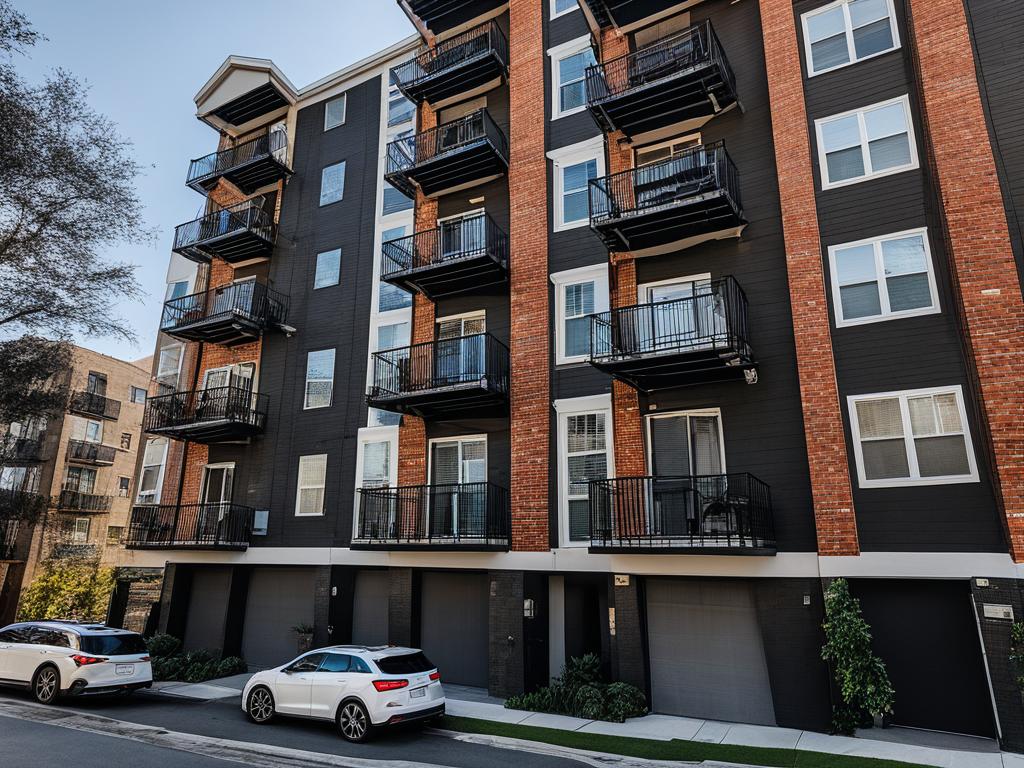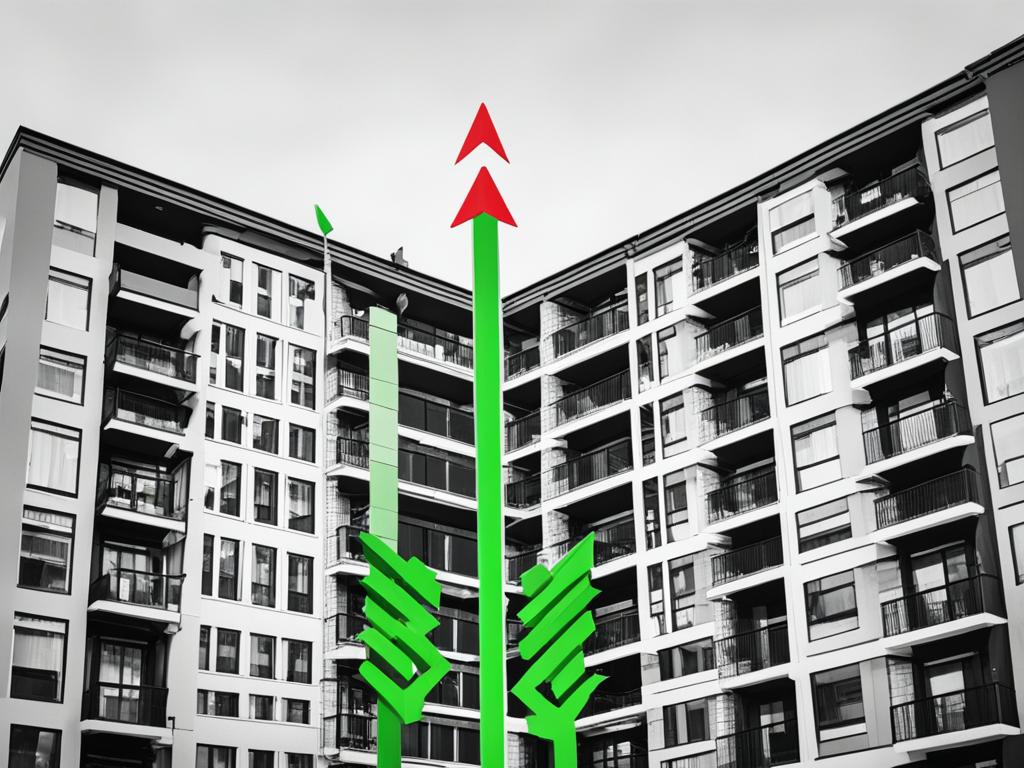Exploring Apartment Syndication Returns
When considering investing in apartment syndication, one of the key factors to evaluate is the potential returns. These returns are projections based on various factors and can significantly impact your investment portfolio. In this article, we will delve into the details of apartment syndication returns, including projected hold time, cash-on-cash returns, and profits upon sale.
Key Takeaways:
- Apartment syndication returns are projections that can impact your investment portfolio.
- Key factors to evaluate include projected hold time, cash-on-cash returns, and profits upon sale.
- Projected hold time is typically around five years, aligning with market changes and property improvements.
- Cash-on-cash returns represent passive income and are usually projected at 8% per year.
- Aim for a profit of around 60% upon sale, generated through property improvements and market appreciation.
Projected Hold Time: ~5 Years
The projected hold time refers to the number of years you would hold the property before selling it. It is recommended to have a hold time of around five years for several reasons.
- Allows for potential market changes
- Completion of property improvements
- Aligns with typical commercial loan terms
A longer hold time provides a buffer in case the market softens, allowing for potential market rebounds.
“Having a hold time of around five years can help mitigate potential market fluctuations and provide ample time for property improvements, ensuring a favorable return on investment.”
Projected Cash-on-Cash Returns: 8% Per Year
Cash-on-cash returns, also known as cash flow or passive income, are a crucial consideration when evaluating apartment syndication. These returns represent the income that remains after deducting vacancy costs, mortgage payments, and expenses. A projected cash-on-cash return of 8% per year is typically considered favorable.
Let’s take a closer look at how this projection can translate into real numbers. For instance, if you invest $100,000, you can anticipate an annual cash flow of approximately $8,000. Over the five-year hold period, this would amount to a cumulative income of $40,000.
Investing in apartment syndication with an 8% projected cash-on-cash return can provide a significant boost to your passive income and overall returns.
Projected Cash-on-Cash Returns
| Investment Amount | Projected Annual Cash Flow | Cumulative Income Over 5 Years |
|---|---|---|
| $100,000 | $8,000 | $40,000 |
| $200,000 | $16,000 | $80,000 |
| $500,000 | $40,000 | $200,000 |
As the table demonstrates, the projected cash-on-cash returns scale with the investment amount, providing even higher potential income for larger investments.
This level of financial return underscores the attractiveness of apartment syndication as a real estate investment strategy. By generating consistent passive income, apartment syndication offers investors a sustainable source of long-term wealth accumulation.
To further solidify your understanding of apartment syndication returns, let’s explore the projected profit upon sale in the next section.

Projected Profit Upon Sale: ~60%
The projected profit upon sale is a significant aspect of apartment syndication returns. Generally, investors aim for a profit of around 60% at the time of sale, five years into the investment. This profit is achieved through property improvements, tenant stability, and market appreciation. By the end of the five-year hold period, investors can expect substantial returns upon the sale of the property.
Investors in apartment syndication can anticipate attractive profits upon the sale of the property. With careful planning and execution, property improvements can increase the value of the apartment complex, allowing investors to realize significant returns. Additionally, maintaining tenant stability throughout the hold period maximizes rental income and enhances the overall profitability of the investment.
Market appreciation is another factor that contributes to the projected profit upon sale. Over the course of five years, real estate values may appreciate, especially in high-demand markets. This appreciation can further boost the profit potential for investors in apartment syndication.
It is important to note that projected profits may vary depending on various market factors and investment strategies. Conducting thorough research and analysis, as well as partnering with experienced syndicators, can help investors make informed decisions and optimize their returns.
Next, we will explore the potential benefits and drawbacks of apartment syndication returns, providing a comprehensive overview of this investment strategy.
Potential Benefits and Drawbacks of Apartment Syndication Returns
Considering the advantages and disadvantages of apartment syndication returns is crucial when making investment decisions. While apartment syndication offers several benefits, it also comes with certain drawbacks that need to be taken into account.
Advantages
- Enhanced Overall Portfolio Diversification: Investing in apartment syndication provides an opportunity to diversify your investment portfolio. This can help mitigate risk and increase the potential for long-term returns.
- Access to Larger Real Estate Projects: By participating in apartment syndication, investors can gain access to larger real estate projects that may not be achievable on an individual basis. This allows for involvement in properties with higher income potential and greater appreciation.
- Potential Passive Income: Apartment syndication offers the potential for passive income, allowing investors to generate revenue without actively managing the property. This can be an attractive option for individuals seeking a hands-off approach to real estate investing.
Drawbacks
- Limited Control over Investment Decisions: When investing in apartment syndication, investors have limited control over the decision-making process. The syndicator is responsible for property management, renovations, and other crucial aspects, which may not align with investors’ preferences.
- Longer Investment Horizons: Apartment syndication typically involves longer investment horizons, often ranging from five to seven years. This may not be suitable for investors seeking shorter-term returns or those with liquidity constraints.
- Thorough Evaluation of Syndicators: Due diligence is essential when evaluating syndicators in apartment syndication. Investors must thoroughly research and assess the track record, experience, and transparency of the syndicator to mitigate any potential risks.
Understanding the potential benefits and drawbacks of apartment syndication returns can assist investors in making informed decisions that align with their investment goals and risk tolerance. It is crucial to weigh these factors against personal circumstances and conduct thorough due diligence prior to investing.
“Investing in apartment syndication provides access to larger real estate projects and potential passive income, but it requires careful evaluation of the syndicator and a longer investment horizon.” – Real Estate Investing Expert
| Advantages | Drawbacks |
|---|---|
| Enhanced overall portfolio diversification | Limited control over investment decisions |
| Access to larger real estate projects | Longer investment horizons |
| Potential passive income | Thorough evaluation of syndicators |

Factors to Consider in Evaluating Apartment Syndication Returns
When evaluating apartment syndication returns, it is essential to carefully consider several factors that can significantly impact your investment outcomes. These factors include the projected hold time, cash-on-cash returns, and profit upon sale. Additionally, conducting thorough due diligence on the syndicator’s track record, experience, and transparency is crucial in making informed investment decisions. Let’s explore each of these factors in detail:
Projected Hold Time
The projected hold time refers to the duration an investor holds the property before selling it. This timeframe is an important consideration as it can affect your returns, risks, and liquidity. Generally, a hold time of around five years is recommended for apartment syndications. This allows for potential market changes, completion of property improvements, and aligns with typical commercial loan terms. A longer hold time also provides a buffer in case market conditions soften, allowing for potential market rebounds.
Cash-on-Cash Returns
Cash-on-cash returns, also known as cash flow or passive income, are an essential aspect of apartment syndication returns. These returns represent the income remaining after deducting vacancy costs, mortgage payments, and other expenses. A projected cash-on-cash return of 8% per year is considered favorable in real estate investing. This steady income can provide financial stability, while the property appreciates in value. For example, if you invest $100,000, you can expect an annual cash flow of approximately $8,000, resulting in a total cash flow of $40,000 over the five-year hold period.
Profit Upon Sale
The projected profit upon sale is a significant factor in evaluating apartment syndication returns. This profit is achieved through property improvements, tenant stability, and market appreciation. Investors typically aim for a profit of around 60% at the time of sale, five years into the investment. This can result in substantial returns on your initial investment. However, it’s important to note that actual profit upon sale may vary based on market conditions and individual property performance.
Thorough Due Diligence
Conducting thorough due diligence is crucial when evaluating apartment syndication opportunities. This involves researching and assessing the syndicator’s track record, experience, and transparency. Review their past performance, the number of successful projects, and their communication and reporting practices. Verify their compliance with regulatory requirements and industry best practices. Thorough due diligence ensures that you are entrusting your investment to a reliable and competent syndicator.
“By considering the projected hold time, cash-on-cash returns, profit upon sale, and conducting thorough due diligence, investors can make well-informed decisions when evaluating apartment syndication opportunities.”

| Factors | Considerations |
|---|---|
| Projected Hold Time | Around 5 years |
| Cash-on-Cash Returns | 8% per year |
| Profit Upon Sale | Around 60% |
| Due Diligence | Syndicator’s track record, experience, and transparency |
Conclusion
Apartment syndication presents a promising opportunity for investors seeking attractive returns and a source of passive income. By carefully evaluating the projected hold time, cash-on-cash returns, and profit upon sale, you can make informed decisions about apartment syndication opportunities that align with your investment goals.
It is crucial to weigh both the benefits and drawbacks of apartment syndication. On the positive side, apartment syndication allows for enhanced portfolio diversification, access to larger real estate projects, and the potential for passive income. However, it’s important to consider the limitations, such as limited control over investment decisions and longer investment horizons.
Before investing, thorough due diligence on the syndicator is essential. Evaluate their track record, experience in the industry, and commitment to transparency. This research will help you choose a syndicator who can effectively manage the apartment syndication and optimize your returns.
In conclusion, apartment syndication can significantly impact your investment portfolio and provide a long-term source of passive income. By carefully considering the projected returns, conducting due diligence, and making informed investment decisions, you can harness the potential of apartment syndication to achieve your financial goals.
FAQ
What is the projected hold time in apartment syndication?
The projected hold time refers to the number of years an investor would hold the property before selling it. It is recommended to have a hold time of around five years.
What are cash-on-cash returns in apartment syndication?
Cash-on-cash returns, also known as cash flow or passive income, represent the income remaining after deducting vacancy costs, mortgage payments, and expenses.
What is the projected profit upon sale in apartment syndication?
The projected profit upon sale is the anticipated profit at the time of sale, typically around 60% five years into the investment.
What are the potential benefits of apartment syndication returns?
Apartment syndication offers enhanced overall portfolio diversification, access to larger real estate projects, and potential passive income.
What are the potential drawbacks of apartment syndication returns?
Drawbacks include limited control over investment decisions, longer investment horizons, and the need for thorough evaluation of syndicators.
What factors should be considered in evaluating apartment syndication returns?
Factors to consider include the projected hold time, cash-on-cash returns, and profit upon sale. It is also crucial to conduct thorough due diligence on the syndicator.

